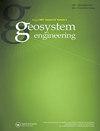Biosorption of cadmium by Enterobacter ludwigii isolated from soil contaminated with cadmium near a coal-fired power plant in Korea
IF 1.1
Q3 GEOSCIENCES, MULTIDISCIPLINARY
引用次数: 0
Abstract
ABSTRACT This study aimed to isolate and characterize indigenous bacteria from cadmium-contaminated soil around a coal-fired power plant in Korea for their potential use in biosorption. The 16S ribosomal RNA analysis identified Enterobacter ludwigii G17–1 in the soil, exhibiting a remarkably high minimum inhibitory concentration (2,500 mg/L) for cadmium. The efficiency of cadmium biosorption was investigated under different pH levels (6–9), temperatures (15–40°C), and initial cadmium concentrations (25–100 mg/L), using both live and dead G17–1. The live G17–1 strain exhibited a maximum biosorption efficiency of 50% for 25 mg/L cadmium at 24 hours, while the highest efficiency achieved with dead G17–1 was 48% at 1 hour. The biosorption capacity decreased as the initial cadmium concentration increased. These findings suggest that the isolated bacterium, E. ludwigii G17–1, holds potential for the bioremediation of cadmium-contaminated water and wastewater.韩国燃煤电厂附近镉污染土壤中分离的路德维希肠杆菌对镉的生物吸附
本文章由计算机程序翻译,如有差异,请以英文原文为准。
求助全文
约1分钟内获得全文
求助全文

 求助内容:
求助内容: 应助结果提醒方式:
应助结果提醒方式:


